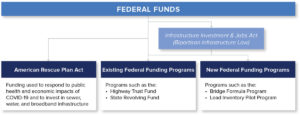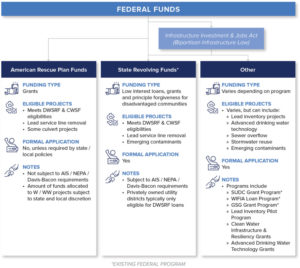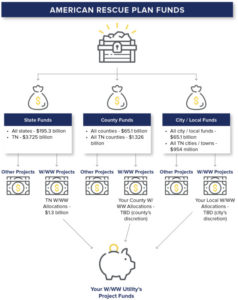
ARPA Funding for the W/WW Industry: What to Know and Where to Begin
If you’re in the water industry, you’ve likely heard that A LOT of money is about to be up for grabs over the next few years due to legislation like the American Rescue Plan Act and the Bipartisan Infrastructure Investment and Jobs Act. The funding opportunities are exciting… but the hundreds of pages of legislative documents that explain them are much less exciting. To help, SSR has broken down what you really need to know and what you can be doing now to maximize the funding your utility can access from these funds. This article will specifically focus on American Rescue Plan Act (ARPA) Funding, rather than the Bipartisan Infrastructure Investment and Jobs Act, as much of the ARPA funding is already available to be accessed.
Overview
What are American Rescue Plan (ARPA) Funds?
The American Rescue Plan Act was passed in March 2021 and provides $1.9 trillion of funding to various entities and programs around the country. While the funds from this Act are commonly referred to as ARPA Funds, don’t be confused if you hear someone referring to them as American Rescue Plan (ARP) funds, State and Local Fiscal Recovery Funds (SLFRF), or Fiscal Recovery Funds (FRF)… while there are some small nuances, they are all more or less the same thing for our purposes.
These funds are not exclusively for water and wastewater projects — in fact, many of the types of projects deemed eligible for these funds focus on the impacts of Covid-19, not infrastructure — however, water and wastewater projects are indeed eligible for funding. Not just that, water and wastewater projects have some of the clearest eligibility requirements out of all eligible projects, making them a safe choice for funding.
Is this the same thing as the Bipartisan Infrastructure Bill, SRF Funding, or the Build Back Better Act?
As confusing as it may be, no. The Bipartisan Infrastructure Bill and State Revolving Fund (SRF) both provide separate sources of funding and are not the same as ARPA Funds. The Build Back Better Act is also completely separate from ARPA Funds and has not yet passed both houses of Congress.


Eligible Projects
What types of projects are eligible for ARPA Funds?
Even though ARPA Funds and SRF Funds are completely separate, you can look at SRF eligibility guidelines to find out what W/WW projects are eligible for ARPA funding. Confusing, I know. As a general and conservative rule, if a project would theoretically be eligible for SRF funding, it will also be eligible for ARPA funding. To be clear, this doesn’t mean that you can only use ARPA funds on projects that have received SRF funding. Rather, it means you can look at eligible SRF projects to get an idea of what projects ARPA funds can be used for. For more information regarding SRF, and therefore ARPA, project eligibility, see the links below:
Water
- https://www.epa.gov/dwsrf/dwsrf-eligibilities
- https://www.tn.gov/environment/program-areas/wr-water-resources/srfp/srf-home/drinking-water-state-revolving-fund.html
Wastewater and Stormwater
- https://www.epa.gov/cwsrf/learn-about-clean-water-state-revolving-fund-cwsrf#eligibilities
- https://www.tn.gov/environment/program-areas/wr-water-resources/srfp/srf-home/clean-water-state-revolving-fund/clean-water-iup.html
Can ARPA Funds be used to cover projects that have already started?
Yes, if the project began after March 3, 2021 and meets all other eligibility requirements then ARPA funds could be used to reimburse costs incurred for that project. It’s not expected that this process will be any different than the regular ARPA funding process, but be prepared to provide documentation confirming that the project did not begin before March 3rd, 2021.
Do the projects need to be completed by a certain date?
Yes, all funds must be obligated by December 31, 2024, and all projects must be completed by December 31, 2026. These deadlines may even be a few months earlier for you, depending on requirements set by your state and local governments, so check with your state and local officials to confirm.
I know…this is not a large window given the size of many projects in our industry. If you are concerned that your projects may not fit in this timeline, you could apply for ARPA funding for just the design portion of a project or you could divide a project into phases and apply for ARPA funding for only the phases that will be completed within this window.
The Three Buckets of Funding
There are multiple buckets of funds??
Yes, for our purposes there are effectively three different buckets of potential funds: State ARPA funds, County ARPA funds, and City ARPA Funds. Each bucket of funds is completely separate, and your utility can potentially access money from all three! The figure below illustrates this:

So there’s more ARPA funding than just what my City already received?
Correct! You can potentially access ARPA money from your city, your county, and the state.
How much ARPA Funding did my city, county, and state receive?
Check out these links to see the total allocations:
- State ARPA Allocations – https://home.treasury.gov/system/files/136/fiscalrecoveryfunds-nonentitlementfunding1-508A.pdf
- County ARPA Allocations – https://home.treasury.gov/system/files/136/fiscalrecoveryfunds_countyfunding_2021.05.10-1a-508A.pdf
- Metropolitan Areas and Cities with Populations > 50,000 – https://home.treasury.gov/system/files/136/fiscalrecoveryfunds-metrocitiesfunding1-508A.pdf
- Tennessee Cities with Populations < 50,000 – https://www.tn.gov/content/dam/tn/finance/documents/neus/NEUWorksheet.pdf
- Kentucky Cities with Populations < 50,000 – https://www.klc.org/userfiles/files/1stDistributions.pdf
Action Items
What can I be doing now to secure City ARPA funding for my utility?
Many cities are already distributing their ARPA funds. Some may be waiting to distribute funds until they’ve developed a comprehensive plan for how they intend to spend it, some may be distributing ARPA funding on a first-come-first-served basis to departments and organizations who propose eligible projects, and others may have already allocated set amounts of money to departments or projects. SSR recommends beginning the following steps, if you have not already.
- Determine who within your city is responsible for allocating the city’s ARPA funding.
- Determine how your city is allocating their ARPA funding.
- Identify eligible projects.
- Identify expected project costs.
- Follow your city’s process to request funds.
Due to the vague language of the American Rescue Plan Act, some cities may understandably be hesitant to allocate their funds. Water and wastewater projects have some of the clearest eligibility requirements of all the potential projects listed in the act, which could work in your favor when advocating for funds for your utility.
What can I be doing now to secure County ARPA funding for my utility?
To begin securing County ARPA funding, utilities should follow the same steps listed above for City ARPA funding but for their county.
What can I be doing now to secure State ARPA funding for my utility?
This section specifically focuses on steps that utilities located in Tennessee and Kentucky should begin to take in order to access Tennessee’s ARPA funds. Utilities in other states should consult their state’s guidance.
Tennessee
If you’re a utility in the state of Tennessee, the good news is that the Governor has given $1.3 billion of the state’s ARPA funding to TDEC to spend on Water and Wastewater projects. The bad news is that the process of applying for this funding is going to be significantly more involved than applying for City and County ARPA funding, and the process will differ depending on whether your utility is a public, municipal utility or a private utility district.
Public Utilities
SSR recommends that public utilities begin the following steps now to ensure they are ready to submit their application for TDEC’s Non-Competitive ARP Grant by the deadline on November 1st, 2022:
Familiarize yourself with TDEC’s Non-Competitive ARP Grant.
- As a public utility, this grant is going to be your primary avenue to receive State ARPA funds.
- Grant Manual – (https://www.tn.gov/content/dam/tn/environment/arp/documents/arp_non-competitive-grant-manual.pdf)
- Slides from TDEC’s recent ARP grant workshop – https://www.tn.gov/content/dam/tn/environment/arp/documents/arp_tdec-presentation_non-competitive-grant-workshop.pdf
Review the maximum allocation of State ARPA funds that your city and county are eligible for through TDEC’s Non-Competitive ARP Grant and review co-funding requirements for this grant money.
- Maximum allocations can be found on pages 40-53 of the Grant Manual (linked above).
- Co-funding requirements can be found on pages 10-11 in the Grant Manual.
Determine which types of projects and grant categories you may be interested in applying for.
- The four grant categories are investigation and planning; investigation, planning, and design; planning, design, and construction; and construction only.
- More information on the categories can be found on page 8 of the Grant Manual.
Fill out the TN Infrastructure Scorecard.
- TN Infrastructure Scorecard Website (contains instructions and link to Scorecard portal) – https://www.tn.gov/environment/arp/infrastructure-scorecard.html
Begin identifying which projects to include in your grant proposal.
- If the results of the Scorecard indicate that your utility has critical needs, review pages 17-21 of the Grant Manual to determine what critical needs projects you will be required to include in your proposal.
- Remaining funding can be used on projects of your choice, so long as they meet the federal ARPA project eligibility requirements. See Eligible Projects section of this article and pages 7-8 of Grant Manual.
Begin reviewing grant application requirements.
- See pages 22-24 and pages 36-39 of Grant Manual.
Submit grant application by November 1, 2022.
- Collaborative proposals can be submitted at this time, and non-collaborative proposals can be submitted beginning on June 1, 2022.
- To access the application, register and log in to TDEC’s Grant Management System (https://tdec.smartsimple.com/s_Login.jsp?lang=1&prole=0), then search for the application titled “DWR-ARP Collaborative Grants State Water Infrastructure Grants (SWIG) Program.”
I know… that’s a lot. The good news is that up to 6% of your total allocation can be used to cover administrative expenses, which can be used to cover fees should your utility choose to contract a consultant to help administer the grant. More information can be found on page 11 of the Grant Manual.
Utility Districts
If you work for a utility district, you unfortunately are not eligible for TDEC’s Non-Competitive ARP grant on your own. However, private utilities are eligible to serve as a partner on a collaborative proposal for the Non-Competitive Grant. Additionally, TDEC plans to announce guidance for a Competitive ARP Grant by January 31, 2023. SSR recommends that utility districts begin the following steps in order to increase their chances of receiving State ARPA Funds.
Review the collaborative proposal guidance on page 13 in TDEC’s Non-Competitive ARP Grant Manual.
Non-Competitive Grant Manual – https://www.tn.gov/content/dam/tn/environment/arp/documents/arp_non-competitive-grant-manual.pdf
Reach out to your county and city about potentially partnering on a collaborative proposal.
Periodically check TDEC’s ARP website for information regarding their upcoming Competitive ARP Grant.
*Please note that the recommendations for both public utilities and utility districts are based upon the 4/18/2022 Update of TDEC’s ARP Non-Competitive Grant Manual. Check TDEC’s ARP website (https://www.tn.gov/environment/arp.html) regularly to ensure you are following the most up-to-date guidance.
Kentucky
If your utility is located within the state of Kentucky, the steps required to receive state ARPA funding are not yet fully detailed. The good news, however, is that we expect more guidance to come your way in the coming months.
What we know so far:
- Within the past few weeks, the state legislature and governor passed the 2022-2024 budget for the state.
- The 2022-2024 budget allocates $250 million of ARPA funds to go towards a Drinking Water and Wastewater Grants program, which will be allocated to each county based on population.
- The Kentucky Infrastructure Authority will be responsible for collecting applications from counties and must have all applications collected no later than November 1, 2022.
What you can do now:
Identify eligible projects.
Begin discussions with county officials regarding their plan for the upcoming State ARPA-funded Drinking Water and Wastewater Grants program.
Regularly check the Kentucky Infrastructure Authority website (https://kia.ky.gov/Pages/index.aspx) for more information regarding the upcoming State ARPA-funded Drinking Water and Wastewater Grants program.








